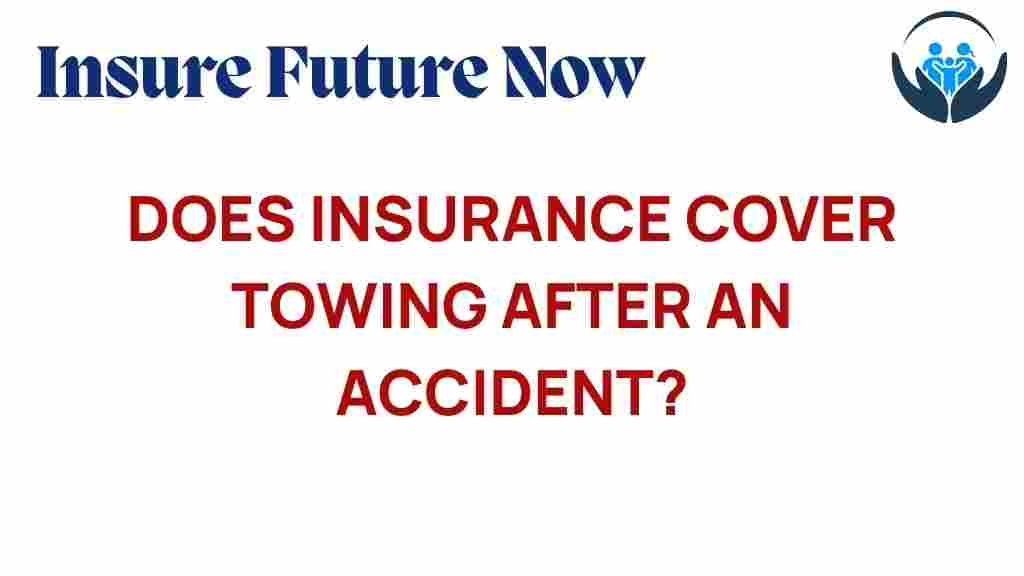Unraveling the Mystery: Does Insurance Cover Towing After an Accident?
Understanding the complexities of auto insurance can often feel overwhelming, particularly when it comes to specific coverage details. One common question that arises after an accident is whether insurance covers towing. This article aims to unravel the mystery surrounding insurance and towing coverage, especially in the context of accident recovery. We will explore various aspects of auto insurance, including roadside assistance, the claims process, and how to navigate policy details effectively.
What is Towing Coverage?
Towing coverage is a form of insurance that provides financial assistance for the cost of towing your vehicle after an accident or breakdown. This coverage can be crucial, as towing fees can add up quickly, especially in emergency situations. However, not all auto insurance policies include towing coverage as standard, making it essential to review your specific policy details.
Types of Towing Coverage
There are generally two types of towing coverage included in auto insurance policies:
- Roadside Assistance: This is a service that provides help when your vehicle is inoperable due to a breakdown, accident, or other emergency. It often includes towing services, battery jumps, tire changes, and fuel delivery.
- Towing and Labor Coverage: This coverage specifically covers the cost of towing your vehicle to a repair shop and may also include labor costs incurred at the site of the breakdown.
Does Your Policy Include Towing Coverage?
To determine whether your insurance covers towing after an accident, you will need to review your auto insurance policy. Here are some steps to help you understand your coverage:
- Review Your Policy Documents: Look for sections that mention roadside assistance or towing coverage.
- Contact Your Insurance Provider: If you’re unsure about the details, reach out to your insurance company for clarification.
- Check for Endorsements: Sometimes, towing coverage may be an add-on to your policy. Verify if you have opted for it.
How Towing Coverage Works After an Accident
If you have towing coverage under your auto insurance policy, here’s how the process typically works after an accident:
- Ensure Safety: After an accident, make sure everyone involved is safe. If necessary, call emergency services first.
- Contact Your Insurance Company: Notify your insurer about the accident and inquire about your towing options.
- Arrange for Towing: Use a towing service that your insurance company recommends, as they may have partnerships that allow for direct billing.
- Keep Receipts: If you pay for towing out of pocket, keep all receipts for reimbursement through the claims process.
The Claims Process for Towing Coverage
Filing a claim for towing coverage may seem daunting, but it can be straightforward if you follow these steps:
- Initiate the Claim: Contact your insurance provider as soon as possible to report the accident and your need for towing.
- Provide Necessary Information: Be ready to give details about the accident, including the time, location, and circumstances.
- Submit Documentation: Provide any required documentation, such as accident reports and receipts for towing services.
- Follow Up: Keep in touch with your insurance company to track the status of your claim.
Emergency Services and Towing
In addition to towing coverage, many insurance policies offer emergency services as part of roadside assistance. These services can include:
- Lockout Assistance: Help if you are locked out of your vehicle.
- Flat Tire Changes: Assistance with changing a flat tire so you can get back on the road.
- Jump Starts: Help if your car battery dies.
- Fuel Delivery: Bringing fuel if you run out while on the road.
Having these emergency services included in your auto insurance policy can provide peace of mind, knowing that help is just a phone call away in case of a roadside emergency.
What to Do If You Don’t Have Towing Coverage
If you discover that your policy does not include towing coverage, there are still options available to you:
- Out-of-Pocket Payment: You can pay for the towing service directly. Keep the receipts for possible reimbursement through your insurance claim.
- Consider Purchasing Add-On Coverage: If you frequently travel or are concerned about potential accidents, consider adding towing coverage to your policy for future protection.
- Explore Third-Party Services: Some companies offer standalone roadside assistance plans that include towing services.
Troubleshooting Common Towing Coverage Issues
Sometimes, you may encounter challenges when it comes to towing coverage. Here are some common issues and troubleshooting tips:
- Claim Denial: If your claim is denied, review your policy for any exclusions and contact your insurer for clarification.
- High Towing Costs: If the towing fee is higher than your coverage limit, discuss options with your insurance agent or seek a different towing service.
- Delayed Reimbursement: Keep all communication documented and follow up regularly with your insurance provider about the status of your reimbursement.
Conclusion
In conclusion, whether insurance covers towing after an accident largely depends on the specifics of your auto insurance policy. Understanding your coverage options, including roadside assistance and towing coverage, is crucial for effective accident recovery. Always check your policy details and reach out to your insurer for clarification on coverage levels and the claims process. By being informed, you can navigate the complexities of auto insurance with confidence and ensure that you are prepared for any roadside emergencies that may arise.
For more information on auto insurance and towing coverage, consider visiting this detailed guide. And remember, it’s always wise to review your auto insurance policy regularly to ensure that you have the coverage you need.
This article is in the category Claims and created by InsureFutureNow Team
